RAIDs are small (about 20 boats or less), informal races organized by
volunteers. The open boats can be rowed or sailed, or both, and different
legs of the race test various combinations of the skills. I am aware of
RAIDs being organized in Scotland and Puget Sound, in addition to Finland
where I have participated three of the last four years. Mike Hanyi from the
Baltimore MD area, now living in Finland, has organized most of these
events. RAID 2008 was organized by Seppo Narinen of Finland,with the
assistance of Mike Hanyi and Peter Lord, an Australian resident in Sweden.
| RAIDs are small (about 20 boats or less), informal races organized by
volunteers. The open boats can be rowed or sailed, or both, and different
legs of the race test various combinations of the skills. |
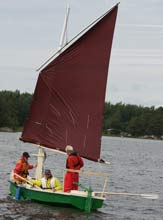 |
During my first RAID in 2005, I crewed for Hawaiians Bonnie and Helona
Tanner in a 24-foot long Shetland Island Yole. Near the end of the first
leg, Mike joined us at the 4th rowing station. Mike commented that rowing
into the wind is actually faster than tacking, at least in these boats.
I combined that information with my experience rowing my Dovekie, and then
my NormsBoat, and asked Jim Michalak to design a boat for rowing and
sailing, with an easily lowered mast, suitable for RAIDs. He agreed and
chronicled the design process in his bi-weekly newsletter. Here are links to
the four articles: (scroll down a bit)
The resulting design, RAIDER, is an open, V-bottom boat with four rowing
position and a sailing rig. She is 7.4 meters long, about 24 feet. Beam is
about 5'8". Draft is about 4' with leeboards down. The balanced lugg sail
has an area of 115 sq ft and is on a 6-meter fiberglass mast mounted in a
tabernacle.
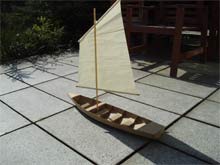 |
Jim Michalak's cardboard model of RAIDER on Wojtek Baginski's patio in Warsaw, Poland |
The next step was to find a boat builder. During the summer of 2006, I
discussed with Wojtek Baginski the possibility of building her in Poland,
but transporting her to Estonia got too complex. The following summer, my
wife Tiiu Kera, an Estonian-American, and I visited boatyards and yacht
harbors on both coasts of Estonia, searching for small boat builders.
However,we found that, with 50 years of pent up desire for luxury denied
during the Soviet occupation, sailors in the Baltics are buying yachts, and
that boat builders aren't interested in devoting time and space to small
hobby boats. Consequently, the bid I got from a professional boat builder
was based on yacht prices: 18,000 Euros (about $23,000 at the time). I
declined.
In December 2007, our Estonian godchildren and their parents visited us for
Christmas. Andres, the father, saw my 18' NormsBoat hanging on her trailer
in the garage and asked to look at the RAIDER blueprints again. He is not a
boat builder, but understood it would not be a difficult boat to construct.
He said he might be able to find resources for us and asked for a copy of
the plans. A few months later, he e-mailed some questions and compared cost
estimates with my expectations. Soon, asking more questions, he sounded like
he had a builder in mind. On 19 May 2008, I suggested that they first build
a model, but Andres responded with "too late" and a photo of a glued-up
hull!
| The bare hull of RAIDER as I found her when I arrived in Tallinn in June 2008 |
 |
I arrived in Estonia in early June with a 50-lb suitcase full of boat stuff,
including the sail from my NormsBoat, 2 PFD's, a mainsheet and halyard, some
wooden cleats, and some small tools. I started helping Rene, a first-time
boat builder, but professional carpenter. A handyman for Andres and his
business partner, Rene was interested in the project as he has worked on the
interior of much larger boats. Fortunately, he spoke more English than I
did Estonian, but the communication was not perfect.
[Tiiu's commentary: As much as the boat builder search had stretched my
downhome Estonian vocabulary into the sailing realm, Norm was pretty much on
his own in communicating with Rene. I was busy leading a group of American
embroiders on a study tour of Estonian needlework.]
The building site was a car repair garage behind a home in a residential
area. It was probably built during Soviet times, perhaps in 1980. It had the
requisite grease pit for servicing vehicles and what looked like a spray
paint area. It was filthy with decades of accumulated grease and dirt, but
it was an ideal size for building RAIDER.
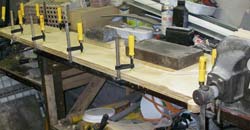 |
I salvaged some space on the front of this bench for a glue station. |
We used local 9mm birch plywood, heavy, 7 plies, very few voids, some
overlap in the plies. We used a local epoxy, mixed by weight, 15 parts
hardener to 100 parts resin. (Is it the "east" system, since we are at about
24East, 60North?) The resin must be heated before mixing, as the overnight
temperature was about 45 degrees F. I discovered among the plans an article
that Rene had downloaded from the internet on building a plywood boat using
epoxy, written in Estonian. With instruction from that article, Rene was
doing a fine job with assembling, taping, and fiberglassing the hull, so I
focused on the rudder, leeboards, mast, tabernacle, and trailer.
AnchorWell - not shown on plans, but quite useful to keep anchor handy. |
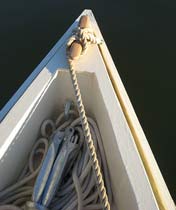 |
For a mast, someone suggested a fiberglass flagpole. Six of us marched 2
blocks up the street to inspect and shake a fiberglass flag pole installed
in the front yard of a home. Fortunately, the owner was absent. I ended up
ordering a 6-meter fiberglass flagpole. When it arrived, Rene cut off the
steel flange on the bottom, and I drilled the appropriate holes for the
fittings and filled the voids it with foam. We epoxied the scrap pieces of
steel into the bottom to act as a counterweight. Since the rig is a balanced
lug, I mounted the main halyard block in the mast, athwartships, rather than
fore and aft. This is the way I have it on my NormsBoat, and it works well.
[Tiiu's commentary: If Norm can speak in terms of "athwartships," why can't
he learn Estonian?]
 |
Flagpole mast purchased from local flag dealer. The steel base becomes a sleeve and extends up 25 inches into the mast. It is a good counter weight. |
For an upper yard, we installed an aluminum mast section from a Laser,
donated by a friend's 18-year old son who is presently in second place among
Laser sailors in Estonia. One end was capped and had an eye, so I left it
that way for the peak end. The other end I plugged with a foot-long piece of
wood with a hole in it for the throat line. I purposely added the weight of
the wood plug to help balance the lug as it is raised or lowered. When being
lowered, the lug is not horizontal, but at least it is not a vertical spear.
| Bending the 115 ft sq NormsBoat sail brought from the US onto the spars - a wooden boom and a piece of Laser lower mast section of aluminum. |
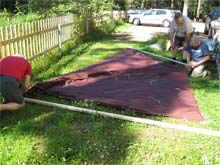 |
The 12-foot boom is a story onto itself. Finding no easy solution, I asked
Rene to glue one up from eight-foot long pieces of 19mm framing lumber
(essentially 1 x 3's), as Jim Michalak recommends. I failed to explain how
to stager the joints. The resulting boom cracked the first day in an 18-knot
wind along the carefully aligned butt joints. At the destination, a Finnish
community center, we considered sistering some pieces of wood to the boom,
but Mike recommended making a new one from a large sapling. We found an
appropriate tree, cut it down, cut it to length, planed off the bark, and
bent on the sail. It was a true community effort with everyone on the RAID
helping. The new boom worked just fine.
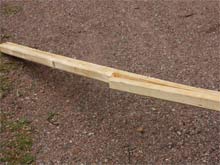 |
The old boom broke at the butt joint. |
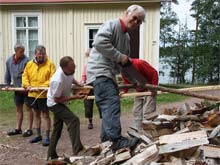 |
After some smoothing with a plane and knives, I cut the new boom to the same size as the old. |
I was not present for the "twisting of the bow". Jim Michalak had expressed
some apprehension about twisting 3/8 (9mm) plywood into the bow shape. I
understand that a total of 5 threaded rods were used, including one to hold
down the bulkhead, plus two straps. It was sufficient, but I think something
slipped, as a strange hollow now exists on both sides near the bow. I do not
know if there was an error in measurement, but I decided to leave it as is.
| Note the straps and threaded rod to pull the bow into shape.
This stage was finished before I arrived in Estonia. |
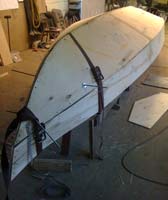 |
I used an 18-tooth hacksaw in lieu of a tablesaw and a bandsaw. The auto
repair garage did have a small drill press, but it was a Chinese table model
which quickly wimped out if the feed rate was too fast. We borrowed a
circular saw for some long cuts, but I would have preferred to cut on a
table saw.
Metric is quite easy and convenient once one gets the hang of it. Scaling is
absolutely simple. I brought along my own "bi-lingual" tape measure and a 6"
caliper, which are both calibrated in both metric and fractions.
Lumber is sized nearly the same as in the US. Boards are 19mm thick, which
is 3/4 inch.
I used good house paint both inside and out, although I got the color wrong
- I wanted a darker green, not the "Kermit the Frog green" I ended up with.
I had a lot of trouble convincing others that house paint was good enough
for this first time out. I plan to re-paint the inside the same off white
with a non-skid added and the outside with a darker green.
[Tiiu's commentary: Oh, good, now I can be a boat widow on two continents.]
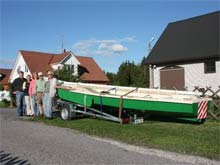 |
Finished boat on Friday, trailer arrived at 5pm, and we trailed her to Andres's home for an 0600 departure for Finland. |
No hardwood is available for a reasonable price; only furniture grade stuff,
imported. Given the latitude, most local lumber seems to be pine-fur-spruce.
I guess all the local birch is used for plywood. I suggested oak for
leeboard guards and was shocked at the price. We therefore used pine with a
reinforcement of 9mm plywood.
We elected to have a trailer built for RAIDER, since a commercial trailer
long enough to accommodate her length would be sprung for a much heavier
load.
| Mary & Ed McGuire - Shallow Water Sailors who normally sail and row a Dovekie on Lake Champlain. |
 |
My crew, Shallow Water Sailors Mary and Ed McGuire from Vermont, arrived at
noon on Friday, 19 July. We had expected the trailer to arrive at 10am, but
it was delayed. While we were waiting, we installed the rudder and some
other last minute items. The trailer arrived at 17:00, and six people loaded
her on the trailer; we then drove her to Andres' home outside Tallinn and
returned to our apartment in the city. At 06:00 the following morning,
Andres, towing the boat, picked us up. We took the 7am ferry to Helsinki,
then drove about 50 miles to Lovisa, where we parked at the hotel and made
preparations for launching. We launched her at about 19:00, well before the
21:30 sunset.
 |
Launched at about 7pm in Lovisa harbor. |
There are some errors, some of which I hope to repair next summer before the
RAID Finland 2009. There are also other ideas I want to try, such as oar
stowage, a sculling slot on the stern, a better mast crutch, and stowage for
a stern anchor (lots of anchoring by the stern in Europe, with the bow tied
to the dock or a tree). There are also a few changes. For example, I added a
shallow anchor well in the bow and access hatches in both bow and stern
flotation chambers. I also sealed the mid ships structure which supports the
mast and leeboards, to provide more flotation. We are still experimenting
with oar lock placement, sheeting arrangements, and so forth.
Ed rowed raider alone from the beach to the ramp. He reported she tracked well. |
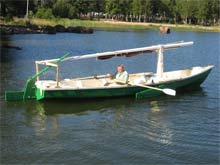 |
RAIDER number 1 is built just as Jim and I envisioned. She is not yacht
quality. I used local materials and house paint [Tiiu's commentary: ...and
some dumpster finds.] I am not concerned if she gets dinged. She was not
expensive to build, and I do not expect to use her more than a few weeks
each summer. She performs exactly as expected: rows well and balances
perfectly under sail, even with all three reefs tied in. And she is fast!
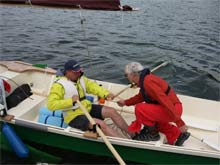 |
Wojtek Baginski (seen here rowing) is a frequent contributor to Duckworks and was my inspiration and counsel for building RAIDER in Northern Europe. |
One more RAIDER for RAID Finland would make a class!
Norm Wolfe
***** |

